Floral Recoveries from the Lagoonal Facies
of Kawai Nui Marsh, O`ahu
Robert Moye, HPU
[Updated October 2012 by webguy@aecos.com]
|
Numerous seeds have been collected from sediments beneath Kawai Nui Marsh during the present (2001) round of auger sampling. These seeds come from sediments lying directly above the basal open marine bay deposits [see reef facies], including about 10 cm interpreted as lagoonal mud and peaty deposits thought to be the oldest marsh sediments.
There are five distinct seed types commonly present (see below). Heidi Lennstrom at the Bishop Museum has identified three as Potamogeton foliosus (leafy pond weed) of the Family Potamogetonaceae, Ruppia maritima (ditch weed or widgeon grass) of the Family Ruppiaceae, and the great bulrush, Schoenoplectus lacustris. All are indigenous wetland species. Two more seed types remain unidentified [NOTE: These seeds have been subsequently identified; see text accompanying photographs below].
We are starting to get some idea of the lagoon margin plant community. It was probably not too dissimilar from the Nu‘upia Ponds on the Mōkapu Peninsula. In addition, single seeds were recovered from two samples that may be from a pre-contact gourd. We did find several gourd fragments in one sample. We also recovered a kukui nut from lagoonal(?) sediments only 2 cm above the open marine deposits. Since kukui (Aleurites moluccana) is a species introduced by the early Polynesians, the finding suggests the non-marine sediment was layed down after the establishment of people in the Islands.
Identification of seeds in peat layer core samples taken in Kawai Nui Marsh provides insights into the changing patterns of vegetation in and around this wetland environment over the last ~1500 years. Shown here are the most common seeds encountered in the prehistoric peat, with a brief description of the plant and where it might grow.
|
|
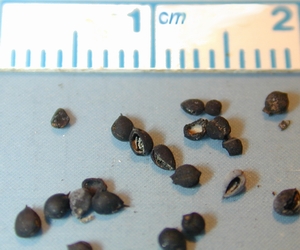
|
 Seeds of widgeon grass (Ruppia maritima). This indigenous aquatic plant grows completely submerged in brackish or subsaline water, typically near the coast. Nearby, Pa‘akai Pond (Nu‘upia, MCBH) sometime harbors widgeon grass when salinity drops into the 20-23 ppt range. Seeds of widgeon grass (Ruppia maritima). This indigenous aquatic plant grows completely submerged in brackish or subsaline water, typically near the coast. Nearby, Pa‘akai Pond (Nu‘upia, MCBH) sometime harbors widgeon grass when salinity drops into the 20-23 ppt range.
|
|
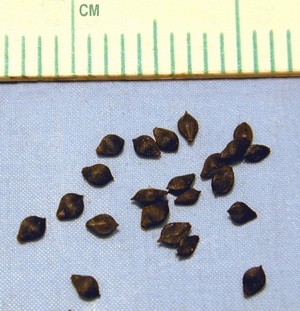
|
 Seeds (achenes) of ‘aka‘akai or great bulrush, Schoenoplectus lacustris, an emergent wetland plant of lowland fresh and brackish water marshes. Bulrush found in Kawai Nui today is mostly S. californicus, a closely related species usually listed as introduced to Hawai‘i, but which may be native (indigenous) as well. Seeds (achenes) of ‘aka‘akai or great bulrush, Schoenoplectus lacustris, an emergent wetland plant of lowland fresh and brackish water marshes. Bulrush found in Kawai Nui today is mostly S. californicus, a closely related species usually listed as introduced to Hawai‘i, but which may be native (indigenous) as well.
|
|
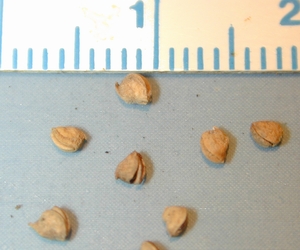
|
 Seeds (achenes) of the leafy pondweed (Potamogeton foliosus). This indigenous aquatic plant grows completely submerged in streams, irrigation ditches, and lo‘i kalo. Seeds (achenes) of the leafy pondweed (Potamogeton foliosus). This indigenous aquatic plant grows completely submerged in streams, irrigation ditches, and lo‘i kalo.
|
|
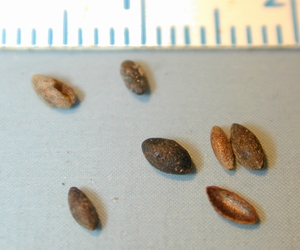
|
 This seed is present in the peat cores, but has not yet been identified. [Note: Arnoud Maurer, a paleo-ecologist in the Netherlands, relates via email that these seeds are Najas spp. (tentatively N. marina; Family Hydrocharitaceae), a genus known in the Hawaiian Islands flora from a single collection made in 1829. Sam ‘Ohu Gon (AML & TNC) provided this link: Smithsonian Search and relates that, more recently, N. guadalupensis (common water-nymph) has been found in Lokoaka Pond and Wailkoa Estuary, Hilo]. This seed is present in the peat cores, but has not yet been identified. [Note: Arnoud Maurer, a paleo-ecologist in the Netherlands, relates via email that these seeds are Najas spp. (tentatively N. marina; Family Hydrocharitaceae), a genus known in the Hawaiian Islands flora from a single collection made in 1829. Sam ‘Ohu Gon (AML & TNC) provided this link: Smithsonian Search and relates that, more recently, N. guadalupensis (common water-nymph) has been found in Lokoaka Pond and Wailkoa Estuary, Hilo].
|
|

|
 A large nut of the kukui tree (Aleurites moluccana). Whole seeds and hulls are found in small numbers in the peat layer down to just above the clay layer, suggesting the presence of this forest tree along the shore or in upstream tributaries throughout the time period of peat formation. The kukui tree was brought to the Hawaiian Islands by Polynesians, presumably around 400-500 AD. [Note: This picture is missing; we are attempting to track it down]. A large nut of the kukui tree (Aleurites moluccana). Whole seeds and hulls are found in small numbers in the peat layer down to just above the clay layer, suggesting the presence of this forest tree along the shore or in upstream tributaries throughout the time period of peat formation. The kukui tree was brought to the Hawaiian Islands by Polynesians, presumably around 400-500 AD. [Note: This picture is missing; we are attempting to track it down].
|
|
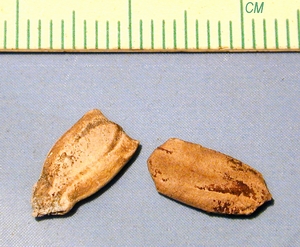
|
 Seeds of an unknown species of Cucurbitaceae, possibly a type of gourd. These are the only two seeds of this type found in the core samples. [NOTE: Joe Moye took these seeds to the Smithsonian collection for possible identification. They were identified as Lagenaria siceraria, the gourd known in the Islands as ipu. However, the seeds are closer in structure to the South American bottle gourd than to those of the Hawaiian ipu plant]. Seeds of an unknown species of Cucurbitaceae, possibly a type of gourd. These are the only two seeds of this type found in the core samples. [NOTE: Joe Moye took these seeds to the Smithsonian collection for possible identification. They were identified as Lagenaria siceraria, the gourd known in the Islands as ipu. However, the seeds are closer in structure to the South American bottle gourd than to those of the Hawaiian ipu plant].
|
|
